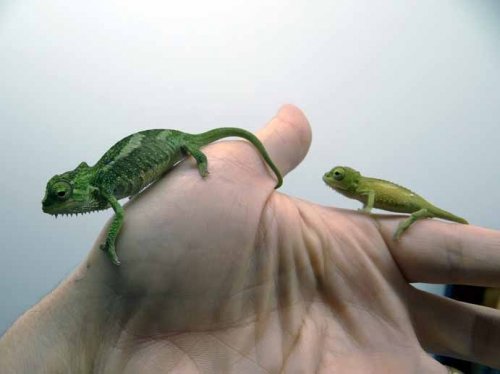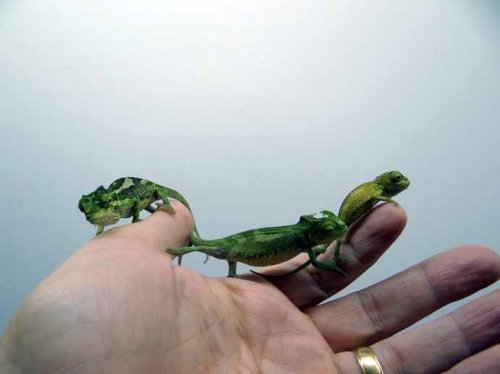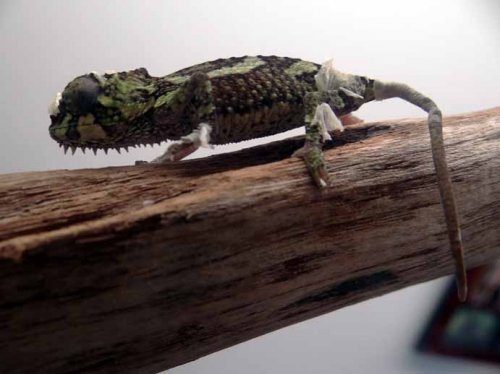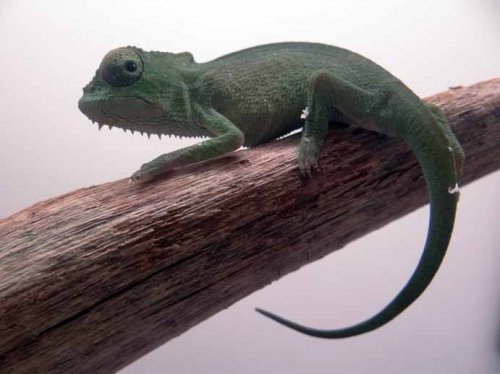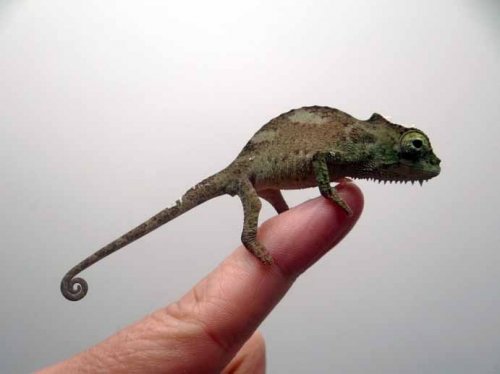pamnsam94
Established Member
This week the babies turn 13 weeks old, but I first want to show you pics from last week. I need to start taking a lot more photos of the biggest ones (actually more photos of all of them), but first, I want you to see what many would consider sub-par animals. I still like 'em though. They are all growing at various rates, but most are close in size. However, it is quite obvious that one is the runt of the clutch. I'm not sure if he'll ever catch up with the others, but he is an eager eater and has a great temperment. When I took him out of his enclosure, he wasn't the least bit shy but was very content to remain upright on my finger. You can see in the pics that the others are easily twice his size. Very cute IMO. 
I'm not sure how often people breed runts (assuming he makes it to breeding size/condition). If that has been studied to any degree with other species (panthers or veilds), or if others have experience breeding them, I'm curious if the number of runts increased at all in the next generations. He may just be one for me or someone else to keep and admire if it wouldn't be a good idea to let him pass on his genes.
The other "sub-par" baby hatched with a kinked tail. He, like the runt, also has a great temperament (very laid back and not shy at all). He/she also is able to use the whole length of her tail just fine. I took video of him/her hatching. If it's a boy, I think I'll call him Curly because in the earliest pics of him, his tail kind of looked curled (reminded me at the time of a pig's tail). If it's a girl, oh I don't know, maybe she'll be called Curly Sue. As a group, there are some I'd say are definitely males and others definitely females, but Curly and a few others kind of confuse me a little.
As a group, there are some I'd say are definitely males and others definitely females, but Curly and a few others kind of confuse me a little.  I'd like to know how much is known about this kinked tail condition (whether it's known how frequently this is a genetic thing (a mutation that we'd want to select against) or simply a developmental thing (not genetically based) that happened as he was growing in his egg.
I'd like to know how much is known about this kinked tail condition (whether it's known how frequently this is a genetic thing (a mutation that we'd want to select against) or simply a developmental thing (not genetically based) that happened as he was growing in his egg.
I'd like to hear about all of your experiences with runts and kinked tails and any insights you might have on those conditions. The other 12, while displaying some variation in size, are. what most would consider, in prime condition. So far (cross my fingers) no edema has showed up on any of them. While I'm lightly dusting most feeders with pure calcium (no D3), I do worry occasionally about providing too much, because it too has been known to cause problems if overdosed. I also dust a single feeding every other week with Repashy's Calcium Plus to provide preformed vitamin A. Unfortunately though, it also has D3. I wish it had none because I believe the quads meet all of their D3 requirements through exposure to UVB radiation. I'm wondering about the Reptivite supplement that has preformed A but no D3. I like that it has no D3 but I'm not sure how the preformed vitamin A compares to the low level of preformed A in Repashy's Calcium Plus. I'll have to look it up. Do any of you use Reptivite (no D3) on montanes, and if so, what frequency? Thanks and enjoy. I'll try to post more pics this week or possibly next.
Perry
I'm not sure how often people breed runts (assuming he makes it to breeding size/condition). If that has been studied to any degree with other species (panthers or veilds), or if others have experience breeding them, I'm curious if the number of runts increased at all in the next generations. He may just be one for me or someone else to keep and admire if it wouldn't be a good idea to let him pass on his genes.
The other "sub-par" baby hatched with a kinked tail. He, like the runt, also has a great temperament (very laid back and not shy at all). He/she also is able to use the whole length of her tail just fine. I took video of him/her hatching. If it's a boy, I think I'll call him Curly because in the earliest pics of him, his tail kind of looked curled (reminded me at the time of a pig's tail). If it's a girl, oh I don't know, maybe she'll be called Curly Sue.
I'd like to hear about all of your experiences with runts and kinked tails and any insights you might have on those conditions. The other 12, while displaying some variation in size, are. what most would consider, in prime condition. So far (cross my fingers) no edema has showed up on any of them. While I'm lightly dusting most feeders with pure calcium (no D3), I do worry occasionally about providing too much, because it too has been known to cause problems if overdosed. I also dust a single feeding every other week with Repashy's Calcium Plus to provide preformed vitamin A. Unfortunately though, it also has D3. I wish it had none because I believe the quads meet all of their D3 requirements through exposure to UVB radiation. I'm wondering about the Reptivite supplement that has preformed A but no D3. I like that it has no D3 but I'm not sure how the preformed vitamin A compares to the low level of preformed A in Repashy's Calcium Plus. I'll have to look it up. Do any of you use Reptivite (no D3) on montanes, and if so, what frequency? Thanks and enjoy. I'll try to post more pics this week or possibly next.
Perry



